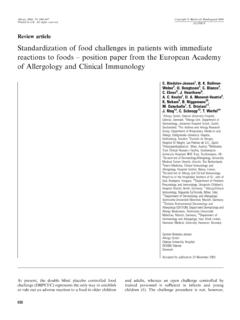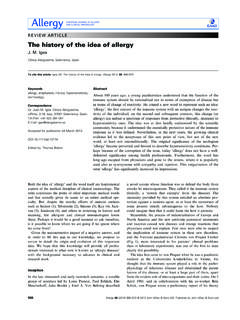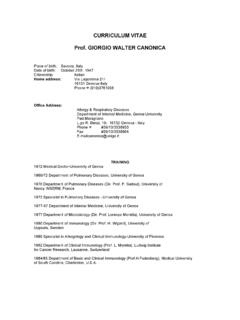Transcription of Plasma Cells Advanced article - Roitt
1 Plasma CellsHeather A Minges Wols,Barat College of DePaul University, Lake Forest, Illinois, USAP lasma Cells are terminally differentiated B lymphocytes that provide protective immunitythrough the continuous secretion of antibodies. Antibody-secreting Cells develop insecondary lymphoid tissue following antigen stimulation and may enter a short-livedplasmacellpopulationthatresid eprimarilyinthenonlymphoidareaofthesplee norlymphnodes, or instead may migrate to the bone marrow where the majority enter a long-livedpopulation of Plasma humoral branch of the immune system is critical forproviding protective, circulating antibodies.
2 In humans,antigen-specific antibody has been detected in the serumfor decades following antigen encounter. The antibodypool is maintained by Plasma Cells , which secrete antibod-ies following antigen soluble antibody is necessary for providing pro-tective immunity to an individual or animal, it must be ableto circulate readily throughout the body as a means ofsurveillance. Because Plasma Cells themselves are notknown to migrate from tissue to tissue, it is importantthat Plasma Cells are situated in tissues such that antibodycan easily enter the circulation.
3 In the spleen and lymphnodes, Plasma Cells are detected among the reticular sinus-oidal Cells in the red pulp and medullary cords, respec-tively, which are rich in vasculature facilitating antibodycirculation. The exact location of Plasma Cells in the bonemarrow is not known, however, it is hypothesized thatplasma Cells interact with the reticular stromal Cells sur-rounding the sinusoidal endothelial Cells , again facilitatingantibody secretion directly into the also:Lymph nodes; SpleenThe Plasma cell literature is often confusing as plasmacells are repeatedly misclassified.
4 It is important wheninterpreting data that one is clear as to precisely whatpopulation of Cells is being examined. Plasmablasts areprecursor Cells of short- and long-lived Plasma Cells andare generally described as a proliferating fraction ofantibody-secreting Cells , often found in the bloodstreamemigrating to organs such as the bone marrow. Plasmacells are simply terminally differentiated noncyclingantibody-secreting Cells . Plasma Cells are not normallyfound in the circulation, but rather remain residents intheir organ of choice for life; any antibody-secretingcells in the blood en route to, for example the bonemarrow, are plasmablasts.
5 With this often ambiguousterminology clear, readers can more effectively evaluatescientific literature regarding Plasma Cells and cell morphologyPlasma Cells are easily distinguished from mature B Cells bytheir morphological appearance. Mature B Cells exhibit ahigh nucleus to cytoplasm ratio, little rough endoplasmicreticulum (RER), and an uncondensed nucleus. In con-trast, Plasma Cells exhibit a small, dense, eccentric nucleus,voluminous cytoplasm containing prominent amounts ofRER and enlarged Golgi (Figure 1).Development, Differentiation andMigrationParallels between B-cell development andplasma cell support in the bone marrowThe majority of long-lived Plasma Cells are detected in thebone marrow.
6 Notably, B Cells , the precursors of plasmacells, also undergo much of their early development in thebone marrow. A critical component of B-cell developmentin the bone marrow is the reticular stromal cell. It providesArticle ContentsAdvanced , Differentiation and and Long-lived Populations of Plasma Secretion by Plasma Production by Plasma Cellsdoi: 1 Characteristic Plasma cell morphology shown of bone marrowplasma Cells stained with haematoxylin and OF LIFE SCIENCES&2005, John Wiley & Sons, Ltd. the contact and growth factors B Cells need toprogress through stages of maturation.
7 Both Plasma cellsand developing B Cells are likely to interact with stromalcells in the bone marrow. Therefore, an important under-standing of the components required for B-cell develop-ment may elucidate similar requisites for Plasma cellsurvival. Studies have begun to identify such B Cells develop within the marrow, the location of thecells change such that maturation proceeds from the outerregion of the bone marrow to the inner region where thecentral sinus is located (Osmondand Park, 1987). Theearlystages of B-cell development are dependent on interactionwith stromal Cells via vascular cell adhesion molecule-1(VCAM-1), as well as the growth factors stromal Cells pro-duce, such as interleukin-7 (IL-7), stem cell factor (SCF)and C-X-C chemokine ligand-12,(CXCL12) among others(Dorshkind, 1990).
8 Without these developmental cues, Bcells cease maturation. Concurrent with maturation andmigration within the marrow, the B-cell precursors losedependency for stromal cell-derived cytokines as well asthe need for stromal cell contact. To ensure emigrationfrom the bone marrow does not occur prematurely, B-cellprecursors are retained in the marrow by chemokines, spe-cifically CXCL12 (Maet al., 1999). Immature B Cells , thefinal stage of development in the marrow and located clos-est to the central sinus, lose expression of CXCR4 (C-X-Cchemokine receptor-4), the receptor for CXCL12, and areno longer retained in the marrow.
9 They enter the centralsinus and migrate to the spleen (Figure 2).See also: Bonemarrow; Chemokines; Cytokines; Interleukins; Lympho-cyte developmentMany of the requirements needed for Plasma cell sur-vival in the bone marrow are parallel to those needed for B-cell development. First, plasmablasts and Plasma Cells ap-pear to regain their dependency for stromal cell interactionand stromal cell-derived factors in the bone marrow. Sim-ilar to that observed of developing B Cells , contact is nec-essary for Plasma cell survival: Plasma cell numbers wanequicklyin vitroif stromal Cells are absent (Minges Wolset al.)
10 , 2002). Although the growth factors indispensable forB-cell development are dispensable for Plasma cell sur-vival, stromal cell-derived factors are still a Cells produce IL-6, which is critical for Plasma cellsurvival. Thus, while the players are different, the interac-tive dependencies of Plasma Cells and B-cell precursors interms of stromal Cells parallel each other in several aspects(Figure 2).Just as chemokines are responsible for retaining B-cellprecursors in the marrow, chemokines appear responsiblefor plasmablast entry into and Plasma cell retention withinthe bone marrow.






